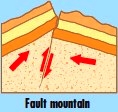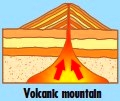MOUNTAINS
From the Himalayas, the world’s tallest mountains, to the deepest ocean trench six and half miles below the surface of the Pacific ocean, the Earth’s surface is slowly changing. Mountains grow inch-by-inch and year-by-year, rivers carve new channels as they rush to the sea, and oceans push and pull at the edges of the land.
Although most mountains are similar in some ways, ranges that have been created by different processes often have different features. Mountain ranges are formed either by the build-up of volcanic rock or by movements within Earth's surface, or crust.
Many mountain ranges consist of chains of volcanoes. Most volcanic mountains are made up of rock that is thought to have melted deep within Earth. This rock rose through the crust and flowed on to the surface in the form of lava. The build-up of lava and volcanic dust forms mountains that are typically steep and cone shaped. Mount Fuji in Japan and Mount Kilimanjaro in Africa are examples of volcanic mountains.
Many other mountain belts have been built by the slow movement of Earth's crust. According to a theory called continental drift, Earth's surface is divided into several separate plates that are constantly moving at a very slow rate. The continents sit on top of these plates and move with them. At times these plates, and therefore the continents, collide and create new landforms. The Alps in Europe and the Himalayas in Asia, for example, are thought to have been created when parts of the crust collided. As the heavier landmass slipped beneath the lighter one, its front edge was scraped away. The scraped-off material piled up into mountains.
The folding of layers of rock at Earth's surface is a related mountain-building process. This folding creates long, parallel ridges and valleys called fold belts. Stronger rocks form the ridges, while weaker rocks are carved into valleys. The Appalachian Mountains of North America are an example of fold mountains. Fold belts commonly include segments where layers of older rocks have been pushed up and over younger rocks. Such segments are known as fold and thrust belts.
Faults, or fractures in Earth's crust, cause the formation of fault-block mountains. Block faulting may occur when blocks of crust between two faults are thrust over neighbouring valleys. The Rocky Mountains of the western United States were formed in this way. Block faulting also occurs where blocks are pulled apart. In these types of mountain ranges, one side is steep but the other has a gentle slope. This is because the blocks on one side drop down, creating steep slopes.
Mountain ranges are natural barriers. Roads are difficult to build across them and railways need expensive tunnels to cross even low ridges. Therefore mountain ranges tend to divide the people on either side of them. They often form frontiers between nations.
Life is hard in mountain lands. The high places of the world are cold and have little soil, making farming difficult. However, many mountain districts serve as holiday resorts where skiing and mountaineering can be enjoyed.
MAKING A MOUNTAIN
Mountains are formed when the
Earth’s tectonic plates move.
• As layers of rocks push against
each other, they buckle and
fold at the edges. Mountains
are pushed up at upfolds, and
valleys are formed in downfolds.
• When the Earth’s crust cracks
on a fault, layers of rock on one
side of the crack can be pushed
up to form a mountain.
• When molten magma bursts
through the Earth’s crust, it
hardens and cools, sometimes
forming a mountain.
• Heat from molten rock in the
mantle pushes layers of solid
rock in the Earth’s crust upward
creating a bulge on the Earth’s
surface.
Mountains are formed when the
Earth’s tectonic plates move.
• As layers of rocks push against
each other, they buckle and
fold at the edges. Mountains
are pushed up at upfolds, and
valleys are formed in downfolds.
• When the Earth’s crust cracks
on a fault, layers of rock on one
side of the crack can be pushed
up to form a mountain.
• When molten magma bursts
through the Earth’s crust, it
hardens and cools, sometimes
forming a mountain.
• Heat from molten rock in the
mantle pushes layers of solid
rock in the Earth’s crust upward
creating a bulge on the Earth’s
surface.




WORLD’S 10 HIGHEST MOUNTAIN PEAKS
Some mountain peaks stand alone high above the surrounding landscape, but most mountains are joined together to form a range. When several ranges of mountains are grouped together, they are called a chain. The world’s ten highest mountain peaks are all in the same range of mountains in Asia - the Himalayas.
Some mountain peaks stand alone high above the surrounding landscape, but most mountains are joined together to form a range. When several ranges of mountains are grouped together, they are called a chain. The world’s ten highest mountain peaks are all in the same range of mountains in Asia - the Himalayas.
| Mountain name | Country | Height (feet) |
| 1. Everest 2. K2 3. Kanchenjunga 4. Lhotse 5. Makalu 6. Cho Oyu 7. Dhaulagiri 8. Manaslu 9. Nanga Parbat 10. Annapurna |
China/Nepal China/Pakistan India/Nepal China/Nepal China/Nepal China/Nepal Nepal Nepal Pakistan Nepal |
29,035 28,251 28,169 27,939 27,824 26,906 26,811 26,758 26,660 26,502 |

Mount Everest - the highest mountain in the world.
THE ANDES
he Andes Mountains stretch from north to south along the entire western side of South America. They separate a narrow strip of land along the Pacific Ocean from the rest of the continent. The Andes are about 8,900 kilometres (5,500 miles) long. Starting near the Caribbean Sea in the north, they run through the countries of Venezuela, Colombia, Ecuador, Peru and Bolivia, and then along the border between Chile and Argentina. In most places the Andes are no wider than 320 kilometres (200 miles). In Bolivia, however, the mountains reach a width of about 640 kilometres (400 miles).
The Andes are not a single line of mountains. In most places they are divided into distinct eastern and western ranges. In Bolivia and Peru, the land between these ranges is a high plateau called the Altiplano. This fairly flat area is about 800 kilometres (500 miles) long and 130 kilometres (80 miles) wide. The waters of the Altiplano drain into Lake Titicaca. At 3,810 metres (12,500 feet) above sea level, Titicaca is the world's highest lake that can be navigated by large boats.
Many Andean peaks are higher than any mountains in Europe or North America. The tallest are in the south, near the border between Chile and Argentina. At 6,959 metres (22,832 feet), Argentina's Mount Aconcagua is the highest mountain anywhere in the world outside Asia.
The climate of the Andes varies according to factors such as location and altitude. In general, the temperature increases from south to north.
he Andes Mountains stretch from north to south along the entire western side of South America. They separate a narrow strip of land along the Pacific Ocean from the rest of the continent. The Andes are about 8,900 kilometres (5,500 miles) long. Starting near the Caribbean Sea in the north, they run through the countries of Venezuela, Colombia, Ecuador, Peru and Bolivia, and then along the border between Chile and Argentina. In most places the Andes are no wider than 320 kilometres (200 miles). In Bolivia, however, the mountains reach a width of about 640 kilometres (400 miles).
The Andes are not a single line of mountains. In most places they are divided into distinct eastern and western ranges. In Bolivia and Peru, the land between these ranges is a high plateau called the Altiplano. This fairly flat area is about 800 kilometres (500 miles) long and 130 kilometres (80 miles) wide. The waters of the Altiplano drain into Lake Titicaca. At 3,810 metres (12,500 feet) above sea level, Titicaca is the world's highest lake that can be navigated by large boats.
Many Andean peaks are higher than any mountains in Europe or North America. The tallest are in the south, near the border between Chile and Argentina. At 6,959 metres (22,832 feet), Argentina's Mount Aconcagua is the highest mountain anywhere in the world outside Asia.
The climate of the Andes varies according to factors such as location and altitude. In general, the temperature increases from south to north.
But even within one section of the mountains - for example, the Andes of Peru and Ecuador - temperatures can range from tropical on the lowest slopes to frigid on the highest peaks. Precipitation also varies widely. A long stretch of the narrow coastal region west of the Andes receives very little rainfall. The desert of northern Chile is one of the driest places in the world. On the eastern side of the mountains, however, rainfall is generally heavy. The highest peaks are covered with snow throughout the year.
Contacts: lubopitno_bg@abv.bg www.encyclopedia.lubopitko-bg.com Corporation. All rights reserved.
DON'T FORGET - KNOWLEDGE IS EVERYTHING!